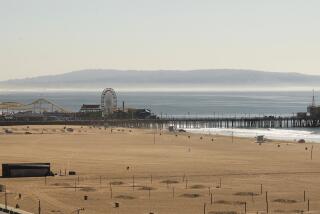Cost to Close Shipyard Put at $1.7 Billion : Defense budget: A study done for the Long Beach City Council says it would far exceed the $8 million a year the Pentagon expects to save.
A study released Monday concludes that it would cost as much as $1.7 billion to close the Long Beach Naval Shipyard and make the land on which it sits useful again, far surpassing the $8 million a year that the Defense Department expects to save by shutting it down.
“They are awesome figures,” said City Councilman Les Robbins. “Given the respective mathematics, it doesn’t seem to be a very good business proposition and that’s what it’s supposed to be--good business.”
The study, commissioned by the Long Beach City Council, is said to be the first to assess what has been only previously guessed at--the cost of boarding up a shipyard that has been a piece of the city’s economic backbone since 1943.
The shipyard is one of 100 military installations targeted by the Pentagon for possible closure or consolidation under a plan to reduce the defense budget in large part in response to political reforms in Eastern Europe.
But according to the study conducted last week, it would cost the federal government as much as $1.7 billion to address the needs of the 4,100 laid-off civilian workers, demolish the dry docks, shops and piers, haul away the debris and repair soil that may have been contaminated by toxins and hazardous industrial materials.
Researchers with Barfield Associates, an industrial cost-estimating service in Los Angeles, spent several hours at the shipyard last week and reviewed figures provided by the federal government to come up with the cost of the shutdown.
“It would be a massive undertaking, a mammoth undertaking,” said Gerald Miller, manager of the city’s Economic Development Bureau. “The cost of making that property usable again would be very, very high.”
The closure would mean an additional $495 million in lost contracts, supply sales and salaries spent in the Harbor area, bringing the total federal and local impact to approximately $2.1 billion, the study said.
The effects would be felt beyond the Long Beach boundaries since only about one-third of the shipyard employees live in that city and cash their paychecks there, officials have said. The rest of the workers are scattered throughout Los Angeles and Orange counties, Miller said. Previous estimates from the local Chamber of Commerce put the anticipated damage to the local economy at only half that.
“Strategically, it becomes a very stupid move,” said Bill Gurzi, a member of the Southern California Save Our Shipyard Committee. “The numbers are staggering. A half-billion dollars is a major, major blow to the South Bay economy.”
The study by Barfield Associates was completed in 36 hours last week, in time for Long Beach Mayor Ernie Kell and five city councilmen to take the results to Washington, where they are meeting with members of Congress to lobby for the shipyard’s survival.
Navy officials in Washington could not be reached for comment on the study.
Since the so-called “hit list” of proposed military closures was unveiled by Defense Secretary Dick Cheney in January, workers, labor unions and city officials have been protesting and picketing to keep the shipyard alive. The Navy yard is one of eight on the East and West Coast that repair and restore ships, and was the only one to finish its work last year more than $20 million below projected costs.
The chorus of protests was joined Monday by Los Angeles Mayor Tom Bradley, who spoke at a rally at the Federal Building in Westwood, where more than 100 shipyard employees took time off work for a protest march.
Bradley promised to lobby Congress to spare the yard. He already has written to Cheney and the secretary of the Navy, arguing that the proposed closure would be a blow to the entire Los Angeles Basin.
Times staff writer Frederick Muir contributed to this story.
More to Read
Sign up for Essential California
The most important California stories and recommendations in your inbox every morning.
You may occasionally receive promotional content from the Los Angeles Times.










